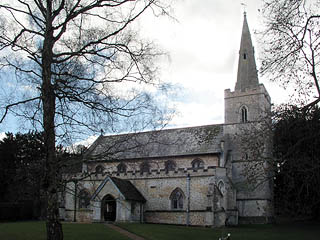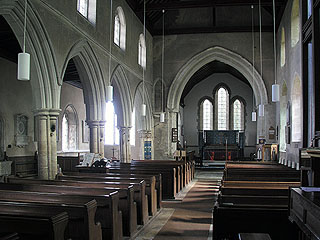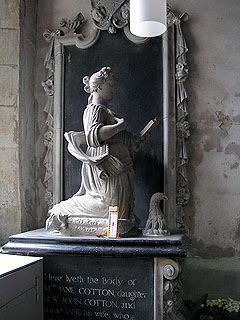The church sits on the edge of the land of Madingley Hall, looking out over the sweeping park and lake. It sits in an impressively bumpy churchyard full of yews - this is a very old religious site, and we have records of a Saxon church having preceded the current building.
The exterior is rather nice; there is no aisle on the south side, so the wall presents an interesting jumble of windows on different levels. The north side is less exciting, since it has been refaced.
The tower is good, though - built some time around the year 1200, with a parapet made of broken fragments from Saxon tombs. The spire is 15th century, although in 1926 it had to be given quite a thorough restoration.
Inside, the piers in the north arcade lean somewhat. There is a very narrow tower arch, and the chancel arch is 12th century. In the aisle there is a tiny piscina - only about ten inches tall - and a little niche whose purpose I couldn't guess at. Other than that, the building itself isn't very exciting. There are some interesting fittings, though.
The font is something of an enigma. It has a square bowl with very weathered decoration on its four faces, in the form of abstract patterns of starbursts, balls and diagonal lines. The guidebook says that this is late Norman; Pevsner thinks it might be 17th century work trying to imitate Norman.
I've certainly never seen another font like it, but Pevsner's suggestion doesn't seem very plausible - for reasons that will shortly become obvious, I should have thought that if they had been replacing the font in the 17th century, it would be decidedly grander than this.
This is because St Mary had, in the Hyndes of Madingley Hall, a rich source of patronage. The dynasty was founded by Sir John Hynde, who managed to raise himself from being an apprentice bookbinder in Cambridge to become a successful lawyer. He was knighted by Henry VIII, and in 1536 built Madingley Hall for his residence.
His descendents became an important part of the county scene. In the late 17th century they married into the Cotton family of Landwade, and many of the combined dynasty have monuments in the chancel. There is an alabaster sculpture of an anchor draped in a flag for Sir Charles Cotton, Admiral of the White who died in 1812.
My favourite was for Jane Cotton, daughter of Edward Hinde and wife of John Cotton (whose very grand tomb can still be seen at Landwade). He died in 1689, and she died three years later. Why was she buried here, rather than with her husband? I don't know, but on her monument is written 'This has been the Burying-place / Of the Hindes for many ages.'
That sounds suspiciously like the Hinde family trying jealously to maintain some sort of independence - why else would you put such a thing on a monument unless you realised that the separate burials for husband and wife would raise eyebrows?
If it was an attempt on the part of the last Hindes to avoid their name being swallowed up, it didn't work - from then on, all the monuments are to Cottons and the name of Hinde disappears from the books. In a sense, Sir John's family has the final triumph, though; in the middle of the 18th century the family moved here to Madingley, tempted no doubt by the much closer proximity to Cambridge, the main roads and (dare I say it) to the seat of the powerful Walpole family. Politics, eh...
St Mary Magdalene seems to be open during the daytime.



